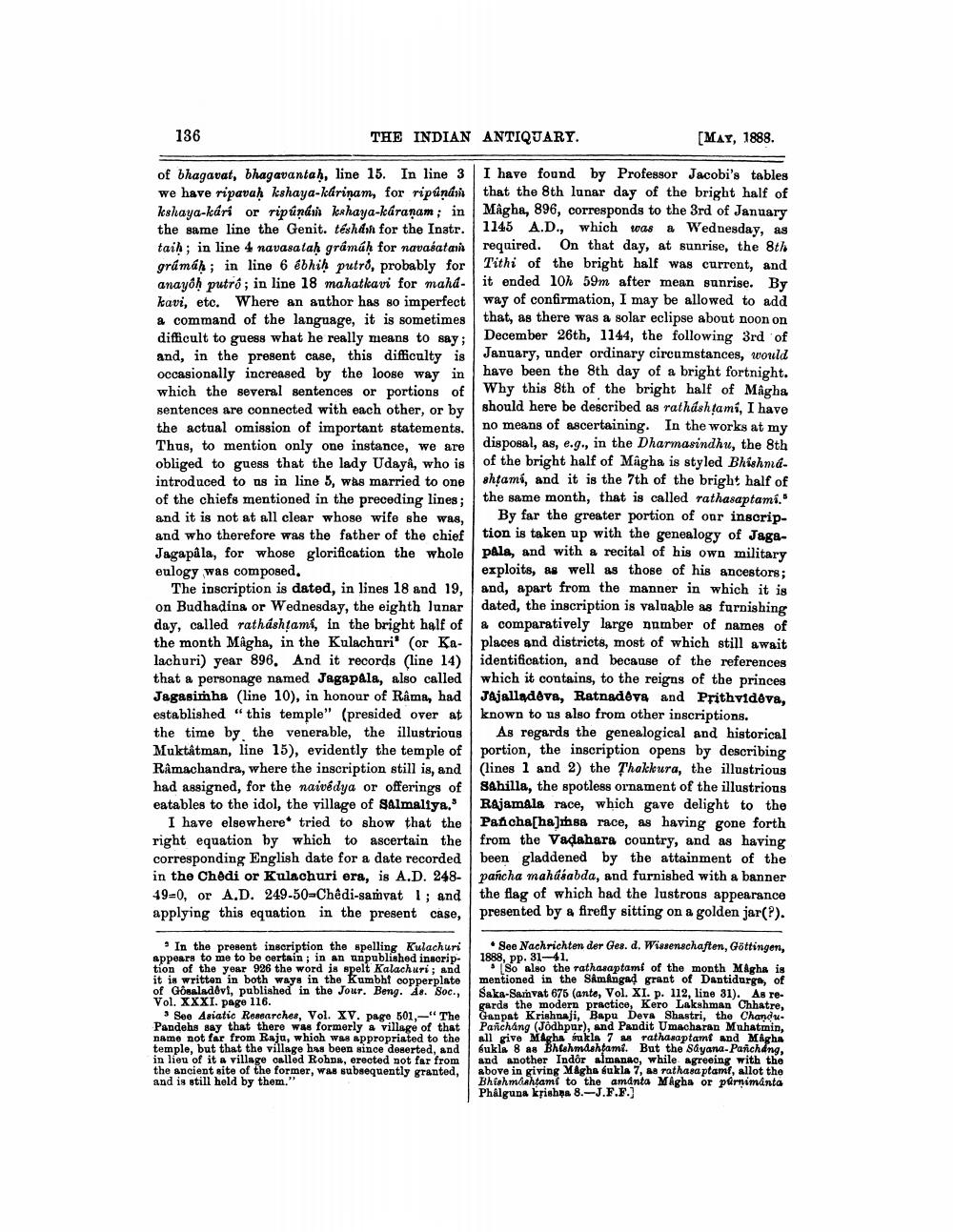________________
136
THE INDIAN ANTIQUARY.
of bhagavat, bhagavantaḥ, line 15. In line 3 we have ripavaḥ kshaya-kárinam, for ripúnám kshaya-kári or ripúnám kahaya-káranam; in the same line the Genit. téshámh for the Instr. taiḥ; in line 4 navasataḥ grámáḥ for navaéatam grámáḥ; in line 6 ébhiḥ putro, probably for anayoh putro; in line 18 mahatkavi for mahdkavi, etc. Where an author has so imperfect a command of the language, it is sometimes difficult to guess what he really means to say; and, in the present case, this difficulty is occasionally increased by the loose way in which the several sentences or portions of sentences are connected with each other, or by the actual omission of important statements. Thus, to mention only one instance, we are obliged to guess that the lady Udaya, who is introduced to us in line 5, was married to one of the chiefs mentioned in the preceding lines; and it is not at all clear whose wife she was, and who therefore was the father of the chief Jagapâla, for whose glorification the whole eulogy was composed.
The inscription is dated, in lines 18 and 19, on Budhadina or Wednesday, the eighth lunar day, called rathashtami, in the bright half of the month Mâgha, in the Kulachuri (or Kalachuri) year 896. And it records (line 14) that a personage named Jagapala, also called Jagasimha (line 10), in honour of Râma, had established "this temple" (presided over at the time by the venerable, the illustrious Muktâtman, line 15), evidently the temple of Ramachandra, where the inscription still is, and had assigned, for the naivedya or offerings of eatables to the idol, the village of Salmaliya."
I have elsewhere tried to show that the right equation by which to ascertain the corresponding English date for a date recorded in the Chêdi or Kulachuri era, is A.D. 24849-0, or A.D. 249-50-Chêdi-samvat 1; and applying this equation in the present case,
In the present inscription the spelling Kulachuri appears to me to be certain; in an unpublished inscription of the year 926 the word is spelt Kalachuri; and it is written in both ways in the Kumbht copperplate of Gosaladevi, published in the Jour. Beng. As. Soc., Vol. XXXI. page 116.
3 See Asiatic Researches, Vol. XV. page 501,-"The Pandehs say that there was formerly a village of that name not far from Raju, which was appropriated to the temple, but that the village has been since deserted, and in lieu of it a village called Rohna, erected not far from the ancient site of the former, was subsequently granted, and is still held by them."
[MAY, 1888.
I have found by Professor Jacobi's tables that the 8th lunar day of the bright half of Mâgha, 896, corresponds to the 3rd of January 1145 A.D., which was a Wednesday, as required. On that day, at sunrise, the 8th Tithi of the bright half was current, and it ended 10h 59m after mean sunrise. By way of confirmation, I may be allowed to add that, as there was a solar eclipse about noon on December 26th, 1144, the following 3rd of January, under ordinary circumstances, would have been the 8th day of a bright fortnight. Why this 8th of the bright half of Magha should here be described as rathashtami, I have no means of ascertaining. In the works at my disposal, as, e.g., in the Dharmasindhu, the 8th of the bright half of Magha is styled Bhishmashtams, and it is the 7th of the bright half of the same month, that is called rathasaptami.
By far the greater portion of our inscription is taken up with the genealogy of Jagapala, and with a recital of his own military exploits, as well as those of his ancestors; and, apart from the manner in which it is dated, the inscription is valuable as furnishing a comparatively large number of names of places and districts, most of which still await identification, and because of the references which it contains, to the reigns of the princes Jajalladeva, Ratnadeva and Prithvidêva, known to us also from other inscriptions.
As regards the genealogical and historical portion, the inscription opens by describing (lines 1 and 2) the Thakkura, the illustrious Sahilla, the spotless ornament of the illustrious Rajamala race, which gave delight to the Pañcha[ha]msa race, as having gone forth from the Vadahara country, and as having been gladdened by the attainment of the pañcha mahúsabda, and furnished with a banner the flag of which had the lustrous appearance presented by a firefly sitting on a golden jar(?).
See Nachrichten der Ges. d. Wissenschaften, Göttingen, 1888, pp. 31-41.
So also the rathasaptami of the month Magha is mentioned in the SamAngad grant of Dantidurga, of Saka-Samvat 675 (ante, Vol. XI. p. 112, line 31). As regards the modern practice, Kero Lakshman Chhatre, Ganpat Krishnaji, Bapu Deva Shastri, the ChanduPanchang (Jodhpur), and Pandit Umacharan Mahatmin, all give Magha sukla 7 as rathasaptamt and Magha 6ukla 8 as Bhishmashtami. But the Sayana-Panchang, and another Indor almanac, while agreeing with the above in giving Magha éukla 7, as rathasaptami, allot the Bhishmashtami to the amânta Magha or purnimanta Phalguna krishna 8.-J.F.F.]




